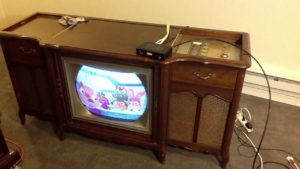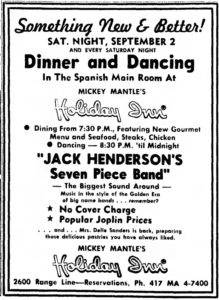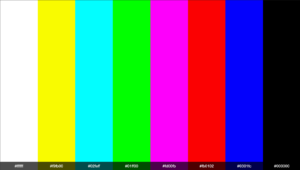
For us Baby Boomers, the appearance of HDTV a few years ago brought back memories of the last big jump in TV technology.
When homes first started sprouting TV antennas in the 50’s, black and white sets were the norm. They weren’t cheap, either. A new one was an investment of hundreds of dollars. Most stations outside of big cities didn’t broadcast in color at first when it became possible in 1954. So spending over $1000 for the pictured 1954 CBS-Columbia color TV was simply out of the question.
But color was catching on fast. By 1965, most US TV stations were broadcasting in color, even though many network shows were still black and white. In fact, it was interesting that some TV shows “jumped the shark” when they went color, the Andy Griffith Show being the prime example.
The prices had dropped by then, as well. You could get a living-room sized color TV for around 500 bucks. So many, including my father, took the color TV plunge about that time.

I saw my first color TV at Mickey Mantle’s restaurant in Joplin, Missouri in 1964. They had one set up in the lobby. I remember standing there stunned at the incredible sight of seeing moving images in gorgeous color.
One of the first things a new color TV owner discovered was that the blasted colors wouldn’t stay the same! It would go in and out of tune during a single show. A nice flesh-colored face might end up with a greenish tint before a show ended. And passing airplanes would also wreak havoc with the picture.

Many homeowners, my father included, decided to spring for a rotor that would turn the antenna around to directly face the transmission tower. In our small northeast Oklahoma town, we had signals originating from places as diverse as Tulsa, Joplin, and Pittsburgh, Kansas. Being able to point the antenna perfectly greatly improved color reception.
Channel 7 in Pittsburgh would begin the broadcast day with color bars that you could use to perfectly adjust the tint and hue. An announcer would describe each color, and you would try to match it. The picture would then be perfect, until it started getting off track again within minutes. Automatic fine tuning appeared in the 70’s and ended this daily ritual.
I waited five years until I took the HDTV plunge. By then, the local networks were broadcasting in it, Dish Network offered a hi-def DVR at a reasonable fee, and the sets themselves had finally gotten reliable and cheaper. And as I installed it, it brought back fond memories of dad proudly hooking up our very first color set, circa 1965.